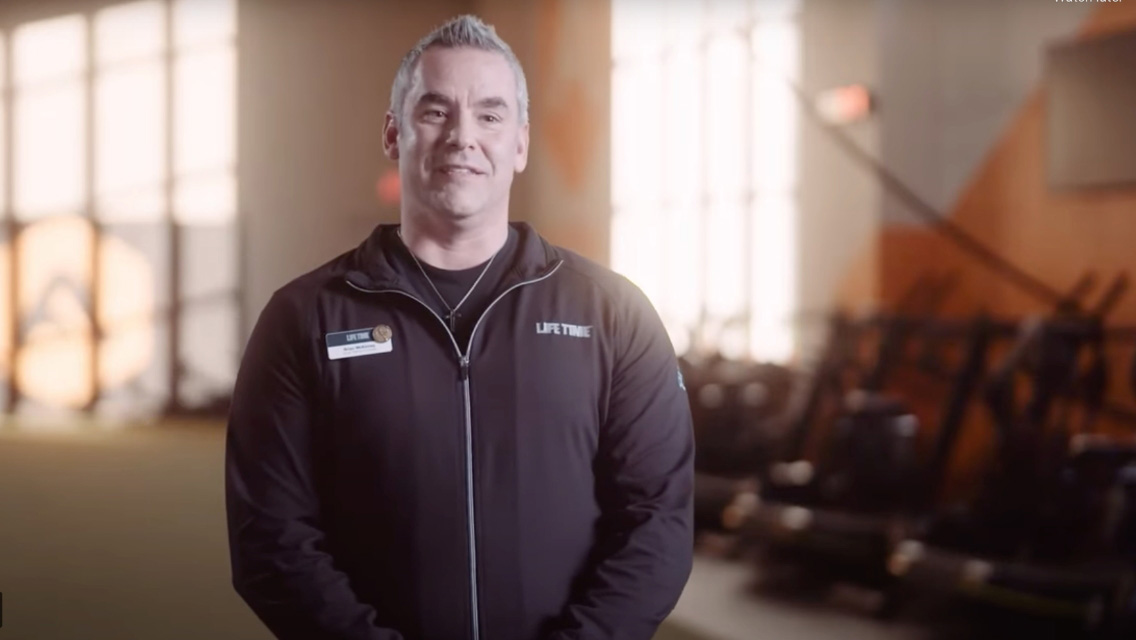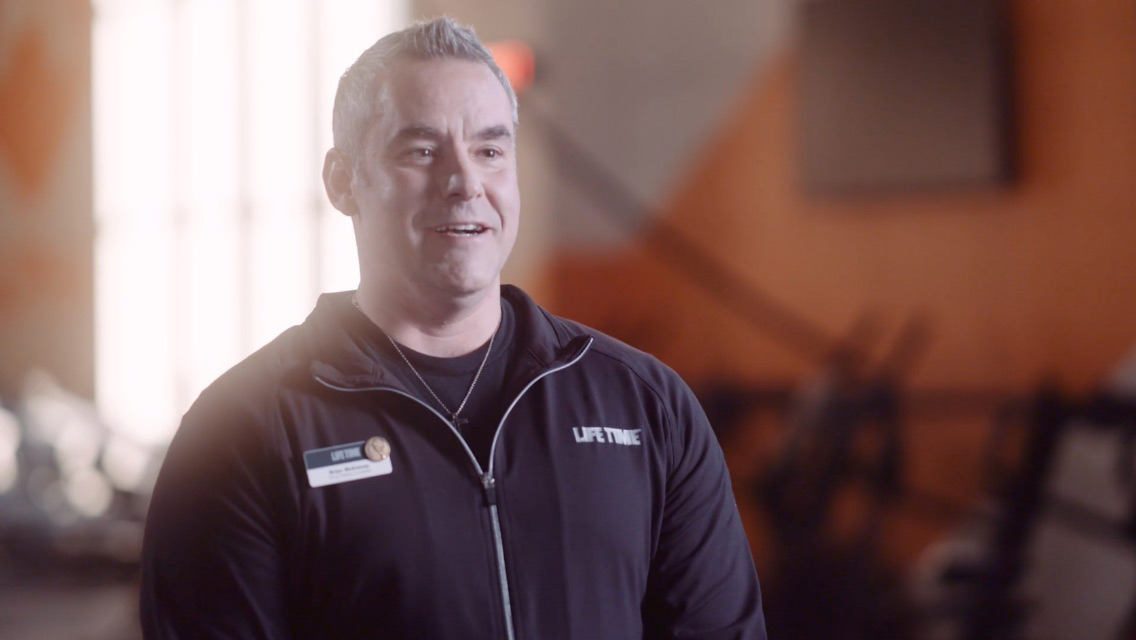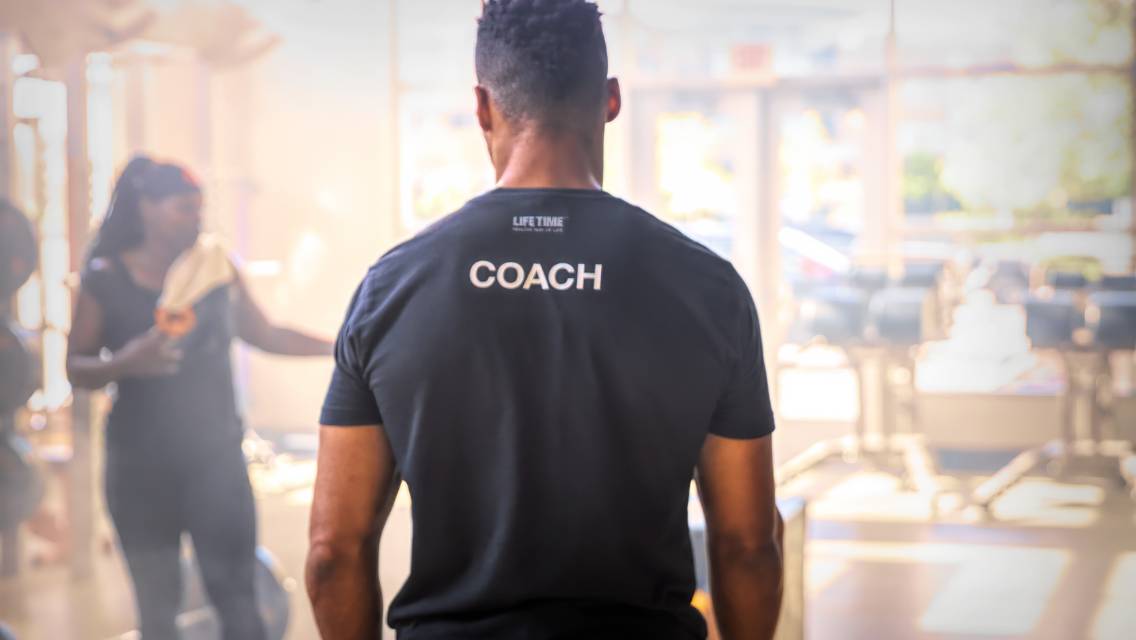Many of us don’t associate ourselves with the term “athlete,” especially when starting out (or trying to reignite) our fitness journeys. Perhaps it seems like a descriptor for the already-fit or like an unreachable goal when we’re just focused on feeling like our best self again.
However, finding a coach and trainer who sees your inner athlete, genuinely believes in you, and doesn’t underestimate your potential can make all the difference in your success, whether your goal is optimizing health, changing body composition, or pushing your performance.
A coach who’s taken pride in doing this for clients for more than a decade is Brian McKinney, one of Life Time’s in-club fitness professionals. He’s successfully championed hundreds of people through and beyond their transformation goals, including five national 60day Challenge finalists — with three of them bringing home the grand prize.
We sat down with McKinney to get to know him better — and to get some of his secrets to success, as well as his mastering-the-basics workout plan.
Brian McKinney, B.S. in Kinesiology, NASM-CPT, Alpha and GTX Coach
After starting out as a trainer in Manhattan, N.Y. in 2009, McKinney began his career at Life Time at the Rochester Hills, Mich. location in 2011. He is currently based out of Life Time in St. Louis Park, Minn.
He prides himself on building genuine connections with clients to bring a deep level of professional care to support their success. His clients often share that, with his guidance, they exceed their own expectations and reach levels of fitness they never thought possible.
McKinney has also been nationally recognized within Life Time for his artistry in building strong, supportive, results-driven communities within the Alpha and GTX training programs.
Life Time Training | What’s your secret to having trained three separate national 60day Challenge winners?
Brian McKinney | I’ll let you in on four secrets. You’ve got to:
1. Foster the right mindset. I’ve been known to say, “Think of everyday life as the regular season and the 60day as the playoffs.”
For those who truly want a change in their life, it’s about taking your health, nutrition, and fitness to the next level. Like the playoffs, you’re that much more focused and dialed in when you’re doing the 60day. And like the playoffs, it should look and feel different than everyday life.
There’s a level of commitment and importance that you’re emphasizing during the 60day, and the stakes should feel personally higher.
2. Praise the small things. As a trainer, it’s an absolute must to praise and recognize the everyday changes and habits that drive success, instead of focusing on what’s missing or where there’s still opportunity. It’s not that you don’t ever bring them up, but I believe we all get beat up enough in life.
Most people underestimate the enormous impact of having someone cheer them on. These small habits are also what, with consistency, actually drive success across the finish line.
3. Be upfront about what it’s going to take. With anyone starting out with the 60day, I’m always straightforward about what will be needed to see results.
Everyone wants that one magic approach. However, there’s no one-size-fits all, cookie-cutter plan. For nutrition in particular, it’s important to prioritize basic principles.
Too many people give up on a strategy if they don’t see immediate change on the scale. I always say, “Pick a lane and drive in it. Don’t swerve all over the place and switch things up too often.”
4. Know the real secret is community. From my experience, community is everything. No one I’ve ever worked with has won in a silo. Group support, accountability, and camaraderie in your health journey is what helps you keep going when you don’t want to anymore.
I also believe that you need to enlist the support of someone other than your trainer or your spouse to walk the journey with you. As a trainer, I can’t do day-to-day life with you. Your spouse can sometimes be too close, and having them alone hold you accountable can cause problems.
Find someone to share the 60day with who you know isn’t afraid to get you back on track if you fall off and who is willing to speak the truth to you from a place of genuine care and concern for your success.
LTT | What’s your go-to form of exercise?
BM | I’m a big believer in that the best results come from doing basic movements with precision and consistency. My workouts almost always default into some variation of each of these, loosely in this order:
- Squat
- Deadlift
- Overhead press
- Row
- Chest press
- Pull-up
Most people can do these six movements and nothing else over the course of a year and see tremendous results.
LTT | When you’re not working or training, what are you doing? Any favorite activities?
BM | I’m a new father, and my wife and I both work full-time on separate schedules. So, while it sounds simple, I truly love just spending time with the two of them, not rushing, and being in the moment. Kids change so fast, and it’s important to me to not miss out on the small things.
It could be having a family dinner together, or it could simply be playing on the ground with my 16-month-old son and watching him discover new things.
LTT | Do you have a favorite mantra or quote?
BM | I once read a book that shared a 17th century Samurai code that read: “Advanced techniques are nothing more than the basics mastered.”
That’s always stuck with me. When it comes to nutrition, it goes back to the basics: water, protein, vegetables, and fruit. For exercise, it’s always about building upon a foundation of basic movement patterns: push, pull, hinge, squat, lunge, and rotation.
LTT | Is there any advice you would share with new trainers?
BM | Listen at least twice as much as you speak, and always remember that your clients’ success is about them, not about you. Whatever they accomplished with your guidance is their accomplishment. Celebrate that.
Also, I often see newer trainers over-thinking program design to the point that they’re almost in a paralysis by analysis state. They waste a lot of time trying to get cute or fancy with movements, when really what matters is connecting with the client directly in front of you. Get them moving safely and consistently, and always be open to pivoting on the day’s plan based on how they are feeling.
If you’re interested in training with McKinney, Life Time members can connect with him here.
Coach Brian’s Mastering-the-Basics Alternating Workout Plan
Designed with the most important movement patterns in mind, this routine challenges your body in different planes of motion that transfer over to your daily life. It’s a total-body workout that hits every major muscle grouping.
For best results, use your estimated one-rep max for each of the following movements first:
- Barbell back squat
- Barbell bench press
- Barbell bent-over row
- Barbell deadlift
- Barbell standing overhead press
- Pull-ups, or band-assisted pull-ups if needed
If you’re unsure of your one-rep max, then be sure your rate of perceived exertion (RPE) is at an eight to nine on a scale of one to 10, with 10 being maximal effort.
Aim to alternate these workouts and do them both twice per week for a total of four days per week. For example, you could do Workout A on Monday and Thursday and Workout B on Tuesday and Friday.
Workout A
| Movement | Repetitions | Weight | Rest Time Between Sets | Sets |
| A1. Barbell Back Squat | 5 | 85 percent of one-rep max or 8 to 9 RPE | 2 minutes | 5 |
| B1. Barbell Bench Press | 5 | 85 percent of one-rep max or 8 to 9 RPE | 2 minutes | 5 |
| B2. Barbell Bent-Over Row | 5 | 85 percent of one-rep max or 8 to 9 RPE | ||
| C1. Cable Standing Rotation | 10 to 12 repetitions | 30 to 60 seconds | 3 |
Workout B
| Movement | Repetitions | Weight | Rest Time Between Sets | Sets |
| A1. Barbell Deadlift | 5 | 85 percent of one-rep max or 8 to 9 RPE | 2 minutes | 5 |
| B1. Barbell Standing Overhead Press | 5 | 85 percent of one-rep max or 8 to 9 RPE | 2 minutes | 5 |
| B2. Pull-Ups (or lat pulldown if needed) | 5 | 85 percent of one-rep max or 8 to 9 RPE | ||
| C1. Stability Ball Crunch | 10 to 12 repetitions | 30 to 60 seconds | 3 |
The Movements
Barbell Back Squat
- Inside a squat rack, position the bar on your upper traps, just below the bony part of the back of your neck.
- Positioned directly under the bar, stand up with the weight and then, taking small steps, back up until you’ve cleared the hooks.
- Initiate the squat by pushing your butt backward and bending your knees.
- Keeping your torso upright, your spine neutral, and your knees in line with your toes, lower yourself as far as you are comfortably able. (If it’s not far, adjust your foot position and try turning your toes slightly outward, but don’t go farther than is comfortable.)
- As you descend, keep your knees tracking in the same direction as your feet, then push off the floor to stand to a full lockout.
- Return to the starting position and repeat.
Barbell Bench Press
- With a bench-press-specific bench and rack, set the barbell at an appropriate height so you can unload the bar from the hooks while lying down on a flat bench.
- While seated, set your feet, then lie back so your shoulders and head are on the bench. Squeeze your glutes and brace your abs to protect your lower back, making sure to keep your shoulder blades in contact with the bench.
- Take a wide grasp on the bar so your wrists are stacked over your elbows in the bottom position (bar rested on your chest). It may take a few sets to get this right.
- Unrack the bar from the hooks. Lower the bar down to your chest, directly across the nipple line or slightly below the sternum. Your shoulders should not hike up in this position.
- Eliminate any bouncing or heaving off the chest by bringing the bar to a half-second standstill on your chest before you initiate the press.
- After a brief pause, press the bar back over your chest. The bar path should be straight and stable in each rep and through the entire set.
- Keep your feet on the floor, and your butt, shoulders, and head all in contact with the bench. If you cannot comfortably plant your entire foot on the floor, use a box or plates next to the bottom of the bench as risers for your feet. Repeat.
Barbell Bent-Over Row
- With your feet slightly wider than shoulder width apart, grip a barbell in front of you with your hands just outside of your legs and palms facing back.
- Hinge at the hips so your chest is about 45 degrees from the floor.
- Draw your shoulder blades together and bend your elbows toward your hips to pull the barbell toward your rib cage.
- Lower the weight with control until your arms are straight and repeat.
Cable Standing Rotation
- Stand perpendicular from the anchor of the cable. Grasp the cable with the hand furthest from the anchor point, and place your other hand overtop.
- Assume the starting position: Hold the handle of the cable at chest level with your arms extended halfway out. Begin with your feet slightly wider than hip width apart, toes pointing forward, and chest rotated to be facing the cable anchor point.
- Engage your core and slowly rotate until you’re opposite from the starting position. Be sure not to allow any movement of your lower body.
- Slowly return to the starting position and repeat.
Barbell Deadlift
- Assuming a shoulder-width stance, feet pointing straight forward or slightly outward, step up to the bar so that your shins are within an inch of the bar, with the bar directly over your mid-foot. From this point on, the bar should remain within an inch of your body. Your shins should be vertical.
- Hinge at the hips and push your butt back as far as you easily can.
- At this point, your hands should be only a few inches from the bar. Bend slightly at the knees until you can grasp the bar.
- With your hands just outside of your legs, grip the bar with a double-overhand grip (both palms facing toward you). This is the grip you will use until the weight is so heavy you feel like your hands will slip off; then you can switch to a mixed grip if you wish.
- Take a breath.
- Get your chest up — someone across the room should be able to read the front of your shirt.
- Push the floor away and stand up with the weight. Exhale as you stand tall with your shoulders back and your chest up at lockout. Your hips should not shoot up before the bar leaves the floor. If the hips move, the bar should move. Repeat.
Barbell Standing Overhead Press
- Place a barbell in a rack at shoulder height. Load it with an appropriate weight (or, if you’re a beginner, use just the bar with no added weight) and stand facing it. Tip: Widen or narrow your grip to find a comfortable position. Keep your elbows close to your body to protect your wrists and shoulders.
- Assume an overhand grip and step close to the bar, allowing it to sit across your chest, on the front of your shoulders. With feet about hip width apart, lift the bar up and step away from the rack. Tip: Stack your shoulders over your hips, drawing shoulder blades back and down.
- Brace your core and glutes and, with control, press the barbell straight overhead, moving your chin out of the way. Once your arms are straight overhead, reverse the movement and slowly lower the bar back to your chest to complete one repetition.
- Tip: As you lift, take care that your wrists are straight and your forearms perpendicular to the floor.
- Tip: Draw your abs in and pull your ribs down to stabilize your shoulders and protect your lower back.
Pull-Ups
- Take an overhand pull-up grip on the bar and hang from it.
- Keeping your arms straight, pull your shoulders away from your ears and your shoulder blades toward your waist (think of performing the reverse of a shrugging movement).
- Keep your chest up and eyes forward, and pull until your chin is higher than the bar.
- Slowly reverse the move, returning to the dead-hang position to complete one repetition.
To make it easier, try a band-assisted pull-up:
- Place a box or bench beneath a chin-up station.
- Hang a heavy exercise resistance band over the bar, then pull the shorter loop through the longer one.
- Stand on the bench and place one foot through the loop.
- Grasp the bar with either an overhand or underhand grip and step off the bench, allowing your arms to straighten fully.
- Keeping your body still, slowly pull yourself upward until your chin clears the bar.
- Reverse the movement and repeat.
Stability Ball Crunch
- Lay with your mid back across the top of a stability ball with your knees bent at a 90-degree angle. Lock your hips at full extension.
- Place your hands so they’re lightly touching your ears with your elbows wide.
- Extend your back, allowing your shoulders to round over the ball for three to four seconds, then engage your core, keeping your hips in a fully locked position, and lift up over three to four seconds into a crunch. Note: Keeping your hips in the fully locked position is crucial for this movement to remain effective.
- When done properly, your mid-back remains in contact with the stability ball. Repeat.




